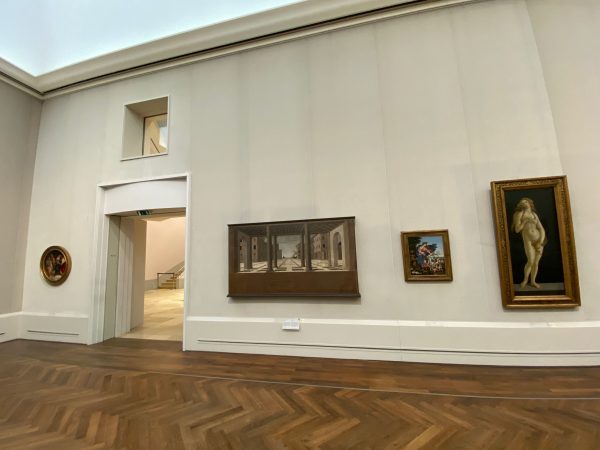Paris has lots of museums to visit. At times, this can lead to a kind of mental overload. The ” Musée Marmottan Monet, in Paris allows to take home a digital and printed copy of your preferred, your own curated collection of images from the museum. This is a great learning experience. You scan the number of the item you want to include and a specialized application retrieves the image of the painting or object from their database into the App. After the visit you take a break in the café in the garden and sort your collection and if you like have it printed within a couple of minutes after you paid for the print or digital version. Upon special request I was told that I am allowed to share the link to the small booklet even on the web (Link to pdf below).
Since the visit to the Musée Marmottan Monet we have come back to the digital and printed versions several times and reading of accompanying texts and perfect quotations of origin make learning about art a fun experience. Going back to lived experiences makes more lasting impressions on our memories. Knowledge coupled with emotions is a powerful way to memorize. Sharing the experience with other persons like the readers of this blog is an additional advantage. Attentive readers of the blog entries will find references to many of the themes dealt with over the years in this series of blog entries. Such topics are: gender and art, technology and society, reflections on time, life courses, inequality, art history, funding of artists, lifelong learning or beauty.
(Booklet below in German LINK-pdf of 6MB. The app allows many language versions. You can produce those yourself from you collection within the App) 
Olympic culture
The Paris 2024 Olympics make a great effort to attract athletes, their families and spectators to the many splendid museums of the city. It is an exceptional offer in the multiplicity of museum experiences the city of Paris and its surroundings have to offer.
The Trocadero near the Eiffel tower, is the place of the Musée d’art moderne de Paris (MAM). For the Olympic Games in Paris the Museum selected works that demonstrate the early impact of sports in the painting of modern times. (See the small extract below on rowing).
A dedicated visit of the permanent exhibition with art works that portray sports is on display during the Olympic season in Paris. The exhibition is a perfect example that you can visit a permanent exhibition with a special interest in mind. In this example it refers to the link of Olympic sport disciplines, their setting in time, space, society and environment). Alternative perspectives on the same collection of art works might deal with the depiction of sports in society or the life course or social status of athletes.
Choose your favourite sports and artists and you will probably find an example that would fit such an exhibition. People looking for depictions of rowing might like the painting by Raoul Dufy, Bord de Marne, Les canotiers painted in 1925.
Almost 100 years later La Marne hosts the rowing competitions of the Olympics. Raoul Dufy shows us that there is much more to rowing than just the sport or exercise. It is a social event not only for the rowers and the onlookers who watch the passing-by of boats and waves.

Artists Robots
We know that the scientific and artistic dealings with robots have a long tradition. Whereas art of impressionism took up the challenge to paint the world outside the studio and embellished technological achievements like bridges and trains post hoc, modern extensions of science fiction to the world of robotics has extrapolated from the present. Artists became forerunners of technical evolution and thereby contributed to the acceptance of artificial intelligence to broader audiences. In 2018 The “Grand Palais” in Paris hosted an exhibition on “Artists & Robots” (Pdf booklet). Jérôme Neuters contributed an essay to the catalog of the exhibition on “L’imagination artificielle” which identified a additional role for artists in combination with AI. Some of the early adopters of the new possibilities of robots assisting artists, Nicolas Schoeffer is quoted to state: “l’artiste ne crée plus une oeuvre, il crée la création”. Like an invention of painting techniques or light or perspective in painting, robots allow a new way of representation of emotions or space. (Image Manfred Mohr, 1974 video Cubic Limit, Artists & Robots p.92-93)

Swimming Pool
Summer time is the time to enjoy outdoors. Hiking, biking, climbing as well as swimming are high on the agenda. With the Olympic games 2024 around the corner we rise to the challenge and get started again with more sports activities. Swimming has many health advantages. Most people think of cardiovascular training and relieve of back pain. Exercise without carrying your body weight is great for your joints and ligaments. The benefits for psychological wellbeing have long been underestimated. Diving into silence under water even if it is only for some seconds or a minute calms your spirit. The water pressure holds you tight without restricting your movements. Breath control is an almost meditative experience. Everyone can do it, again and again. Childhood memories, good and bad, are associated with swimming. Choose your style, costume and pool. The summer break is an ideal occasion to test the marvelous experience again of cold or warm water. The cold water bucket challenge of everyday life takes a break. Time to find your pool again. (Image extract from Susanne Hay, Swimming Pool II, 1996 in private collection, exhibition in Yerres, summer 2023)

Impressionism 150
How many impressions made impressionism? Too many to be expressed in a single number. 150 years after the movement started with a spectacular exhibition in Paris the admiration of the paintings still attracts huge crowds. As a kind of revolutionary movement the artists mounted their own exhibition as they were not allowed to expose their paintings in the official exhibition of the Academy of arts in 1874. They accumulated a sufficiently large group of artists to form their own distinctive style of paintings. Painting outside in the countryside was a joint predilection. The regions, nowadays in the suburbs of Paris where many people daily commute to Paris has discovered the attraction to review the original scenario of the paintings as well as their living environments. Yerres, for example, hosts in 2024 an exhibition to show paintings from Claude Monet and Gustave Caillebotte which highlights the inspiration both painters took from the surroundings. Nowadays it is also interesting to see that the agglomeration makes efforts to make more people aware of the treasures to see in their own surroundings. Even if conservation of nature is hard to achieve the parks of yesterday have remained visible today. For us to transmit the cultural heritage and landscape to future generations as well. An affordable booklet that documents the cultural heritage allows people to dig deeper into the subject also for those who live in the region only because of a job nearby in Paris or Orly airport.

Planned Inspiration
There many ways to search for inspiration. “Moi aussi, comme les peintres, j’ai mes modèles” wrote Jacques Prévert a famous French poet years ago. Scientists find inspiration in data or theories, or in the combination of both. The planning of inspiration is, however, an other issue. You plan for something you don’t know what it is going to be. This makes the endeavor more risky and at the same time me exciting. As a social scientist going out into the “real” life is a sort of inspiration as multiple challenges await an explanation or deconstruction. The overview of current exhibitions through the scanning of catalogues from ongoing exhibitions is a welcome source to organize inspiration for the months to come. A glance through the catalogues gives a fairly good impression of what will be on display. The ideas can fly to distant locations and bring back more food for thought. It is a great service from the Munt library in Brussels. The combination of work and travel for inspiration is an interesting field of study in itself.

Plastic wasted
The amount of plastic that is wasted exceeds our imagination. Even in the most distant islands we find remaining pieces of plastic from our careless consumption. The European Directive 2019/904 has set the limit on detached bottle tops to July 2024. The industry waited until the last few months to implement the old directive. Great that there is hope to find less detached plastic in oceans across the world in some years at least. The behavioral change to move beyond plastics everywhere in our nutrition delivery system is long overdue. We shall get used to bring our own bottles for a refill or other devices to reduce plastic waste further. The change begins with thinking about the topic and finding suitable reusable packaging solutions for yourself. Children learn in art projects about the importance and creativity potential to reuse otherwise wasted materials. Reduce and re-use can be turned into an own competence. Competence in sustainability has been neglected for decades in school curricula, despite its importance for our own health and survival. (Image James Ensor exhibition and competition KBR, Brussels 2024-7)

Narrative Object
Objects tell stories. Stories get condensed into narratives. Narratives become objects. Yes, we are going round in circles here. Artists have transformed an old splendid atelier and factory building into a new gallery space for “Objects with narratives” in Brussels. We construct, reconstruct and deconstruct narratives almost continuously. However, if narratives are transformed into an object or objects they will become something tangible or a fixed expression of the moment or process. The concept of art objects with narratives invites us to look for the narrative linked to the object. Just like in other disciplines like economics we have ample dominant and heterodox narratives. It is important to reflect on narratives and empirical evidence in their support. When we look at the mountains of plastics and garbage on our planet we see how an economic narrative has been turned into nasty objects. Objects with narratives is also how future generations will confront us with the pollution and waste objects we left and still leave behind us. (Image Bussels Gallery Objects with narratives 2024-7-13 Exhibition Marius Ritiu.)

Art or Profession
In political science it is a long tradition to discuss, whether politics is an art or a profession. The idealist tradition, going back as far as Plato in ancient Greek history of ideas, puts the exercise of politics near the exercise of a divine art to do justice. Much later in the history of ideas Max Weber rather bluntly defined politics as a profession (original in German) that requires to master a set of competences.
Recent elections in Europe (EU, France, UK, Belgium) and around the globe (India, USA) in 2024 add interesting case studies to the old question. Is politics an art or a profession?
In modern politics the life course or life cycle of a politician consists of at least 2 phases: (1) the electoral campaign before and (2) the potential of governing or opposition. Each phase requires a different set of competences. In phase 1 it is important to propose a new or different ideal from the previous government. Charismatic presentation of an ideal set of policies is asked for. In phase 2 it is required of the politician to forge compromises, either within the own political party or beyond boundaries of political parties. Certainly, in multi-level governance systems like the European Union additional forms of coalition building across countries is required, intercultural competence or language skills are an advantage here.
The 2 phases of the life cycle of a politician require different sets of skills. Charisma as mentioned by Plato and Weber can get a politician into power and charismatic leadership can get you through a lot of coalition building. On the other hand, modern campaigning in repeated elections is a specialized competence that resembles marketing expertise as well as “reading of statistics” and in-depth analyses of shifting or stable preferences of electorates and to succinct conclusions on this basis. Running a political party or a parliamentary group is yet another leadership skill just like communication skills that, beyond many prejudices, can be learned.
In a nutshell. Politics is an art and a profession. The art consists in the variable combination of different sets of competences. Art requires competences just as professions can be turned into art. Welcome to the hybrid world of modern politics. (Image extract from MAD Paris, Picasso, Schiaparelli) 
Searching Beauty
The search for beauty is an endless story of humanity. We have searched for it almost everywhere. Depicting beauty is probably the oldest form of artistic endeavors. We have invented numerous ways to find and represent beauty in a rather restless manner. We tend to find it in other persons of the same or other gender. The challenge is to keep trying to see the beauty in persons when others don’t, or don’t admit to it. Andy Warhol made this search for beauty his primary aim in his life as well as for his artistic work. The “Neue Nationalgalerie” in Berlin presents the, at times controversial, perspectives on beauty through the eyes and artwork of this exceptional artist. Beauty is at times a holistic concept or a detail by detail, piece by piece approach. Being open to other visions and versions of beauty is the major thrust of Warhol’s work. There is so much beauty around we just have to bother to focus on it. If not satisfied design it yourself. Start with a tour of exhibitions and experience the endless scope of imagination through the eyes of artists. (Image from Warhol exhibition in Berlin 2024 Neue Nationalgalerie, series „Ladies and Gentlemen“ 1975)

Aussensicht Innensicht
Die Sicht vom Skulpturengarten der Neuen Nationalgalerie auf die laufende Ausstellung „Zerreissprobe…“ erlaubt einen tiefen historischen Einblick in die 1980er Jahre. Die Sammlung von Postern des Künstlers Klaus Staeck zeigen die bewegenden Themen der achtziger Jahre. Frauenrechte, Umweltschutz, Sicherheit sowie Medienwirtschaft. 40 Jahre später beschäftigen uns weiterhin, Lösungen für die plakatierten Themen zu finden. Images können Themen so zuspitzen, dass Anklagen daraus werden. Texte sind im Vergleich zu der Eindrücklichkeit der Bilder ein vergleichsweise stumpfes Schwert. Es ist aber gerade die Verbindung von Bild und Text, die Eindrücke verstärkt. „Meme“ Creators sind ein standard tool das die Kommerzialisierung und die Promotion weiter befördert haben. Kunstformen hatten diesen Trend bereits vorweggenommen.

Attune Spheres
In Berlin it is easy to walk through the history of art to up-to-date contemporary art installations. Just walk from the Alte to the Neue and then to the Contemporary Nationalgalerie. With the installation and performance in the monumental Hamburger Bahnhof the artist Alexandra Pirici succeeds in an extraordinary way the combined impression of several art formats. I felt particularly attracted by the sound and resonance that the dancers achieved in the huge historical hall of the former train station. Embedded in a choreography that spans the whole hallway and the top of a sand dune, the ideas of „Attune“ bring in demonstrations of scientific experiments as well. We are reflecting on how structures, biological, physical or geologic processes coexist. It is another example of the intersection of biological, psychological and social phenomena. The links between science and art are more direct than what most people tend to believe. This encompassing experience catches all our senses and our mind. It is very likely that this intense experience in the museum space, which attunes our sensory perception of the artwork, sticks with us for longer than many other pieces of art. The 21st century will reveal an even more powerful language of art as it incorporates even more formats to grab our attention and imagination. The research of how patterns are formed is an important question for social scientists as well. All approaches to the subject are welcome and each one reveals our knowledge gaps despite remarkable progress. (Image: Hamburger Bahnhof, Berlin 2024-5-11, Alexandra Pirici) 
Puccini Media
In honor of Giacomo Puccini the Media enterprise Bertelsmann features one of its treasures. In cooperation with the “Archivio Storico Ricordi” of Milano, Italy, 100 years of Puccini’s oeuvre is celebrated with this exhibition. Fans of Puccini’s operas will have to visit the archives but the interest of this small exhibition lies in the impressive success story of Puccini and his publisher (part of Bertelsmann). Continuous innovation and adaptation to new media, like disks, accompanied an extraordinary marketing campaign throughout the 100 years. Even today there are cycling tours around Puccini’s hometown for the modern eco friendly tourists. We learn a lot about how the media industry functioned in the 20th century. It was absolutely vital to fighting for the rights of authors, composers and rights to receive royalties for performances as well as for the publishing on media. The exhibition in “Unter den Linden 1” is just next door to the Staatsoper which also gave honor to Puccini’s “Madame Butterfly” in 2024. His uncompleted Opera Turandot closes the exhibition with his rough sketches of the final scene. Merchandising is not an invention of the 21st century, but almost a century old tradition. This exhibition is a great testimony for this. It remains an important effort to allow authors and composers to gain a comfortable living during their lifetime. The gains for humanity as a whole are enormous.

Infinite Landscapes
The “Alte Nationalgalerie” celebrates the 250th birthday of Caspar David Friedrich in Berlin. With a considerable effort to unite in one exhibition many paintings and drawings that stem from other collections of public and private origins. This particularly remarkable as a section of the exhibition is devoted to paintings that were intended originally to be seen next to each other (compare catalogue p. 233). Comparing 2 images from the same painter evolve into a narrative. This raises curiosity as in some instances the 2 paintings do not treat the same subject. Your very own interpretations and associations will make for an individual journey through the sheer endless spaces. The exhibition allows to grasp some of the many questions posed by the period of enlightenment not only in Germany. After “God is dead” what will happen? How is mankind defined? What is its relationship to nature? Are we just left alone or what comes after individualism? Even for painters, much like scientists, it is just as important to pose the right questions. Leaving the exhibition with more questions than answers will put you in the “Berlin state of mind” of 200 years ago. Greiswald, Dresden, Rügen and Copenhagen as well as nearby mountains were influential locations and landscapes for Caspar David Friedrich. Berlin 1906 „Jahrhundert Ausstellung“ made him famous again, despite decades of being forgotten. Yet another question to ponder and wonder about. An additional merit of the exhibition is the section on painting techniques and the use of his sketches and drawings for the preparation of the oil paintings. The final riddle to be solved is the price differential between the German and English version of the catalog in the bookshop next to the usual merchandising props.
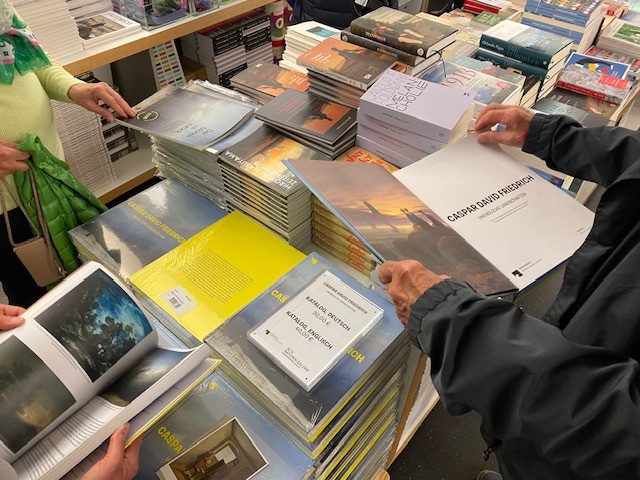
Opera Politics
We know that sports and international politics have ample links. This holds true for Opera performances, either due to the way they are presented or due to the content of the libretto. The opera Jeanne d’Arc (Giovanna de Arco, Jungfrau von Orléans) by Guiseppe Verdi was composed in 1844 and had its Premiere at La Scala in Milano 1845. The libretto is based on the drama written by the playwriter Friedrich Schiller. Later in the 19th century musical pieces followed that dealt with the court judging Jeanne d’Arc. The opera by Verdi creates a strong female voice and character which outperforms men around her. Obviously, she was and remains for many a quasi-mythological heroine. In short, this constitutes great plots for drama and operas. This is centuries old despite the rare occasions of more recent performances of Jeanne d’Arc in form of Verdi’s opera or other forms.
The Opera as arena of politics is currently tested in the Opera at Tallinn Estonia. Due to the aggression and occupation of Ukranian territory by Russia the plot of Jeanne d’Arc regained another European location of potential application. Ukraine pushed back the Russian invasion and struggles to win back its territory from the invaders. The performance of the Opera recreates an impressive Jeanne d’Arc in the person of Elena Brazhnyk who was trained at the National Tchaikovsky Music Academy of Ukraine. The evening inspired hope in many respects. Talents from Ukraine or trained in Ukraine reach out into to the world. Similarly, we have much reason to be inspired by courageous acts. Operas do politics. “Bravi”, as they say in Italian.
(Image: Opera Tallinn-Estonia2024-4-18)
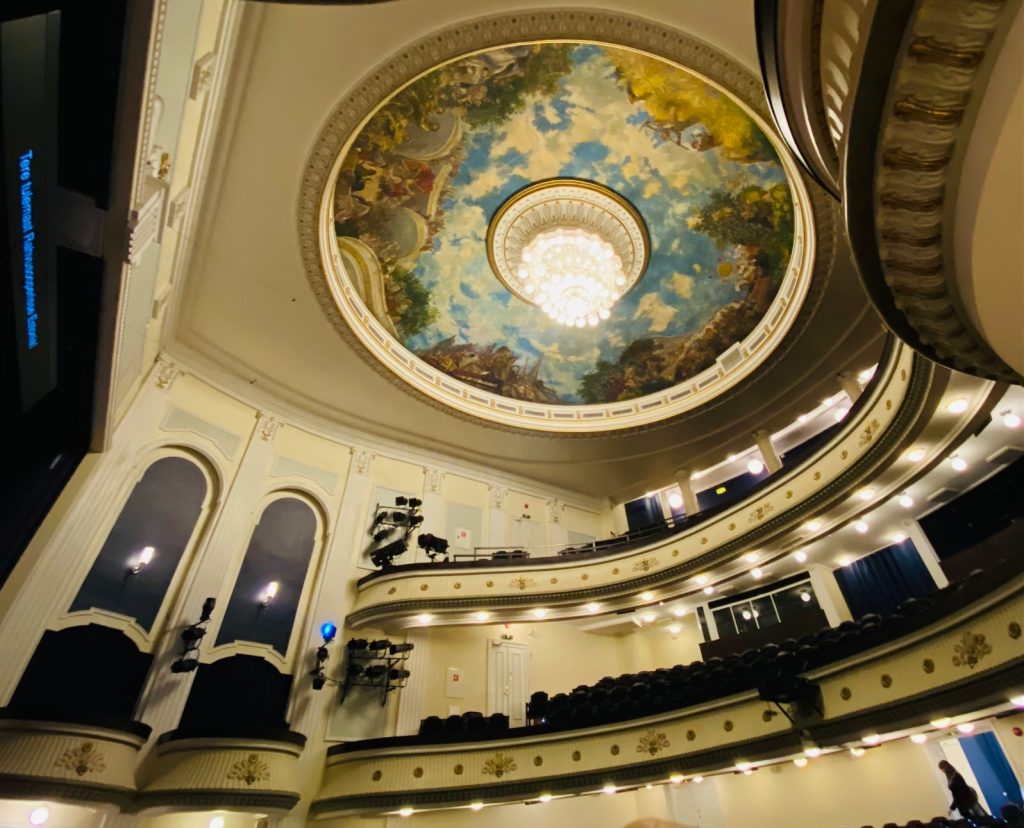
Puppets Museum
The puppet theatre is still a tiny part of the theatre world. The century old tradition has roots in all cultures across the globe. The Puppet Theatre Museum in Tallinn has a fine selection of puppets to perform theatre pieces from India, China, Indonesia and Europe. Storytelling is part of humanity and learning through narratives distinguishes us from other species. Religious traditions have appropriated these techniques just as modern performing arts. From the carnival tradition of using masks not only children adore playing with characters. The famous founder of the Estonian Puppet Theatre has his small monument outside the historic building in the old town, but a big puppet theatre with 400 seats. The adventures of Jules Verne have been played there just as most well known operas or children’s tales. Puppets comment on puppets (Mickey Mouse) just as they take on political debates. The forthcoming piece on the Ministry of Solutions sounds promising indeed. We envy the puppets that have a Ministry of Solutions rather than lots of ministries and ministers but no solutions.
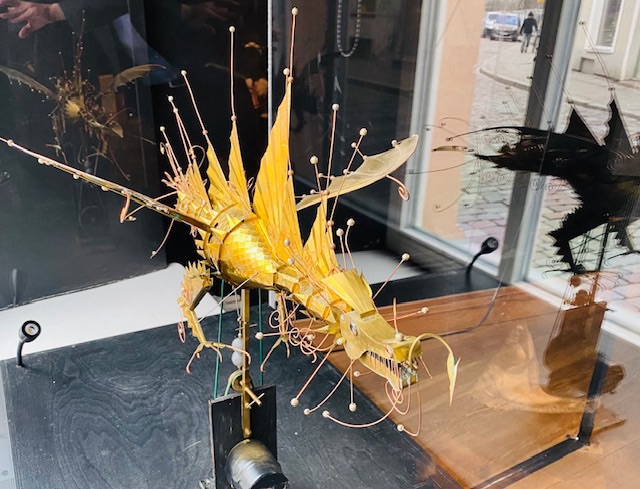
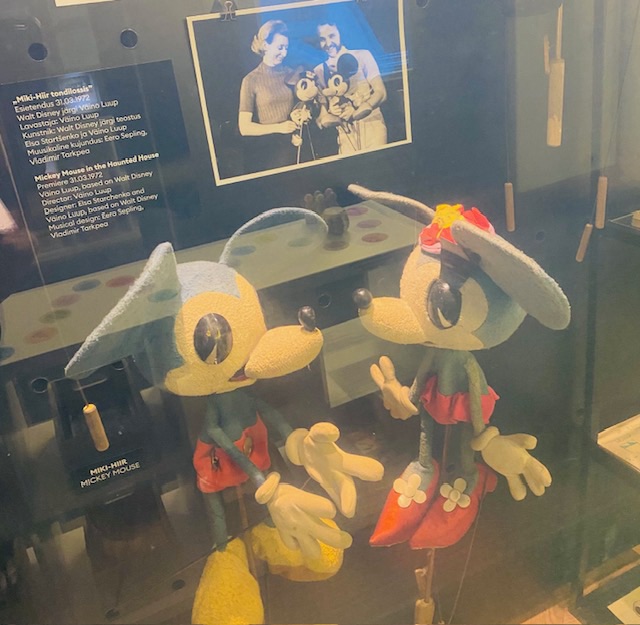
Theory Literature
There still is a lively debate at the margins of literature and the commerce around it about theories of literature. Even if the best of years of theories about literature have passed, in 2024 we see several revivals of theoretical perspectives on literature. Travelling in Europe we celebrate, for example, the 100 years of Belgian and international surrealism in Brussels. The French artist and theorist André Breton was preparing in his thoughts the art and literature of surrealist inspiration. Of course, we think of Magritte as one of the eminent figures of the painted surrealism. Franz Kafka, who died relatively young in 1924, was the author in the spirit of the surrealist movement. The powerful impact of literary theory and theory of art to form communities of practice have had lasting effects, which fascinates large audiences in 2024. Exhibitions across Europe reflect the importance of these art movements to understand European culture, inspirations and aspirations.
Not least through this revival of the surrealist artists in the broadest sense we are returning to a more theory-driven view of literature a bit like 100 years ago. I find it remarkable to read in “Le Monde Livre” of 2024-4-12 the article on “Défense de la théorie” by Tiphaine Smoyault (p.8 see quote below) with a comment on the book by Florent Coste on the usefulness of a theory of literature to understand the world around us. Reworking of language is the contemporary concern of literature: pluri-linguistic experiences, re-discovering oral performances, irony in language and digging into archives are the major strands of contemporary literature. Theory of literature reflects on the past and allows to synthesize the present. For some it also enables to project into the near future of what is going to be published. In any case the theory of literature provides orientation in a huge ocean of published oeuvres. Writing or painting with ideas ahead of your time has been a painful experience for most of these artists. Some artists or authors are lucky to become famous during their lifetime, but lots have struggled for years or never learned that their contributions advanced humanity for more than a hundred years. 
Ne pas rire
The exhibition of surrealism in Belgium at Bozar has the inviting title “Histoire de ne pas rire”. Even the booklet of the exhibition guide does not translate this into English assuming everybody has at least that much of interest in French and the willingness to learn about these 5 words that are a reference to the understanding of the surrealist art movement. You are explicitly invited to allow yourself to laugh when looking at the images. Reflection comes second. Caught by surprise and making new connections of seemingly unrelated images and words, that’s the essence of it. The comparison of the 2 versions of the exhibition guide teaches language and translations beyond the simple words. Sometimes it is best to not translate the text as in the title of the exhibition guide.
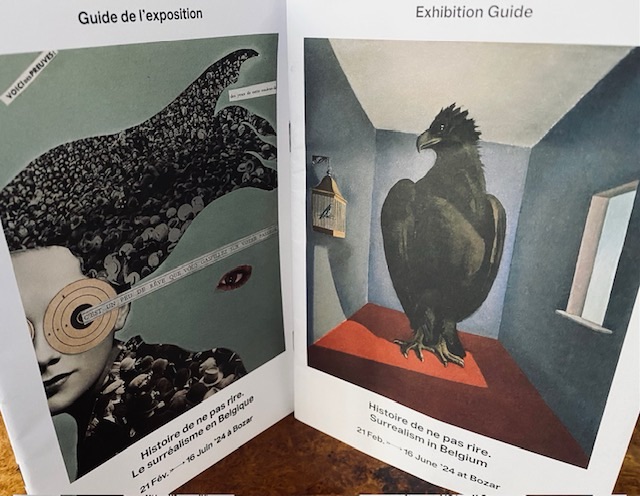
Surrealist 100
Belgium celebrates 100 years of surrealism with a special exhibition in Brussels at Bozar in 2024. The arts movement has much more to offer than just paintings from Magritte. Many other painters and intellectuals that were instrumental to create and perpetuate the movement are represented there. The French philosopher Breton as spiritus rector of the movement contributed innovative ideas and challenged the artists to do further and further on their journey to explore freedom of expression and freedom of association. The exhibition is centered around the surrealist idea to explore the association of words and images. This time the words are on the walls of the rooms and the images put up in the rooms as kind of obstacles on your journey. Keep challenging, keep questioning the sense of things and our imagination. The journey goes on and there are many artists who are still influenced by surrealism, for example Folon. The texts and images take you along on the journey into the surrealists’ world. If you want to challenge your own way to see things and the associative world, this is the place or catalog to refer to.
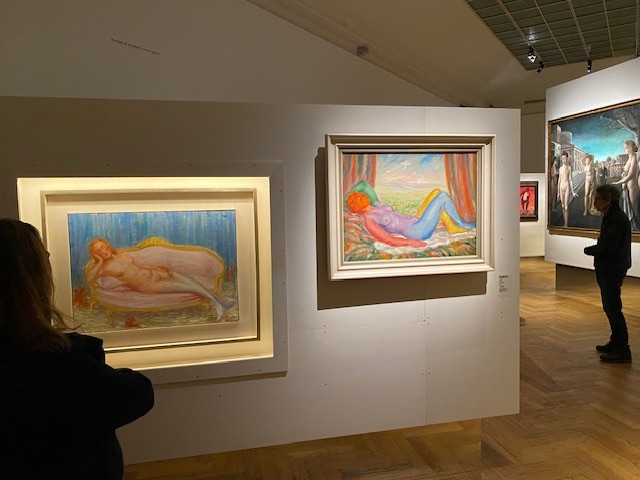
Korallenriff
Kinder verstehen direkt, dass es sich lohnt, Korallenriffe zu erhalten. Plastikmüll in den Meeren gefährdet die Korallenriffe und die bunte Vielfalt an Fischen, die darin leben. Ein kleines Theaterstück dazu von Kathrin Brunner begeistert Kinder, weil es sie erleben lässt, wie einfach Lösungen aussehen können. Den großen Leuten zeigen, wie traurig die Welt aussieht ohne die farbenfrohe Pracht der bunten Fische, wird sie schon zu Veränderungen bringen. Das Theaterstück und Buch dazu wurde am 16.3.2024 im FEZ in Berlin aufgeführt. Das Figurenspiel mit überleitendem Refrain, das vom Publikum gleichsam der Promenade in den „Bildern einer Ausstellung“ (Mussorgsky) mitgesungen haben, bildete jeweils eine gelungene emotionale Überleitung und Aufmerksamkeitspause. Wir wünschen uns noch viele kleine und große Besuchende für diese Aufführungen. Die Kinder werden es uns schon lehren, den blauen Planeten noch zu retten.
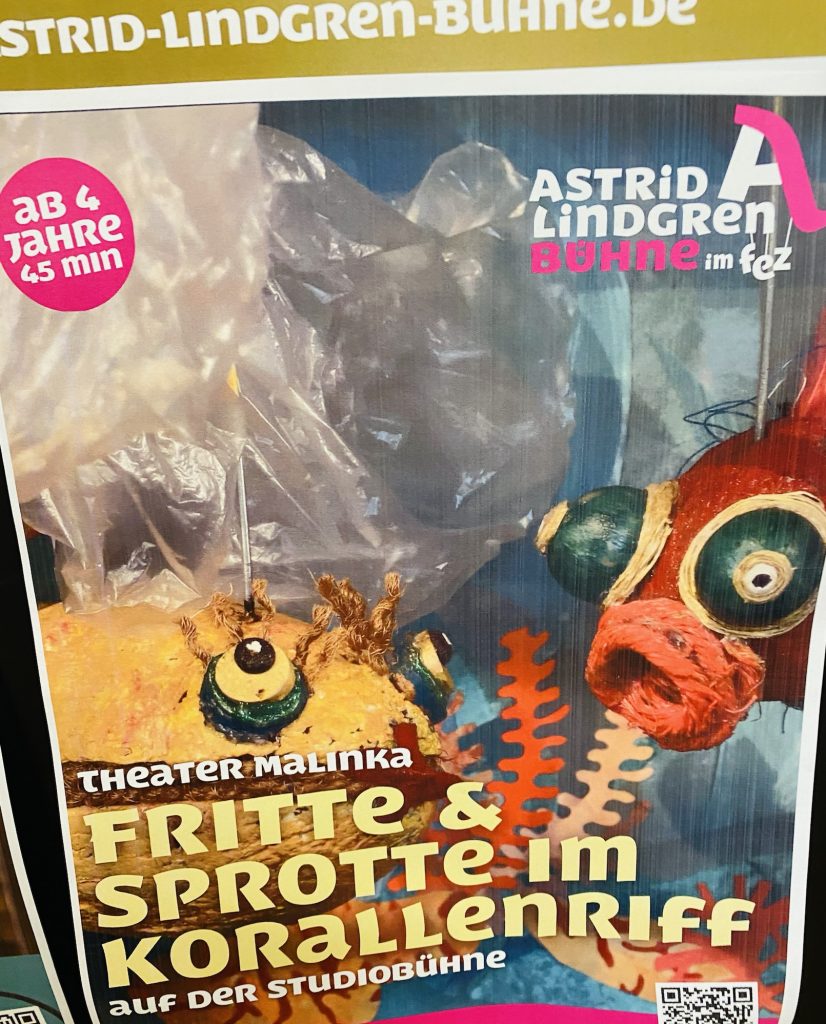
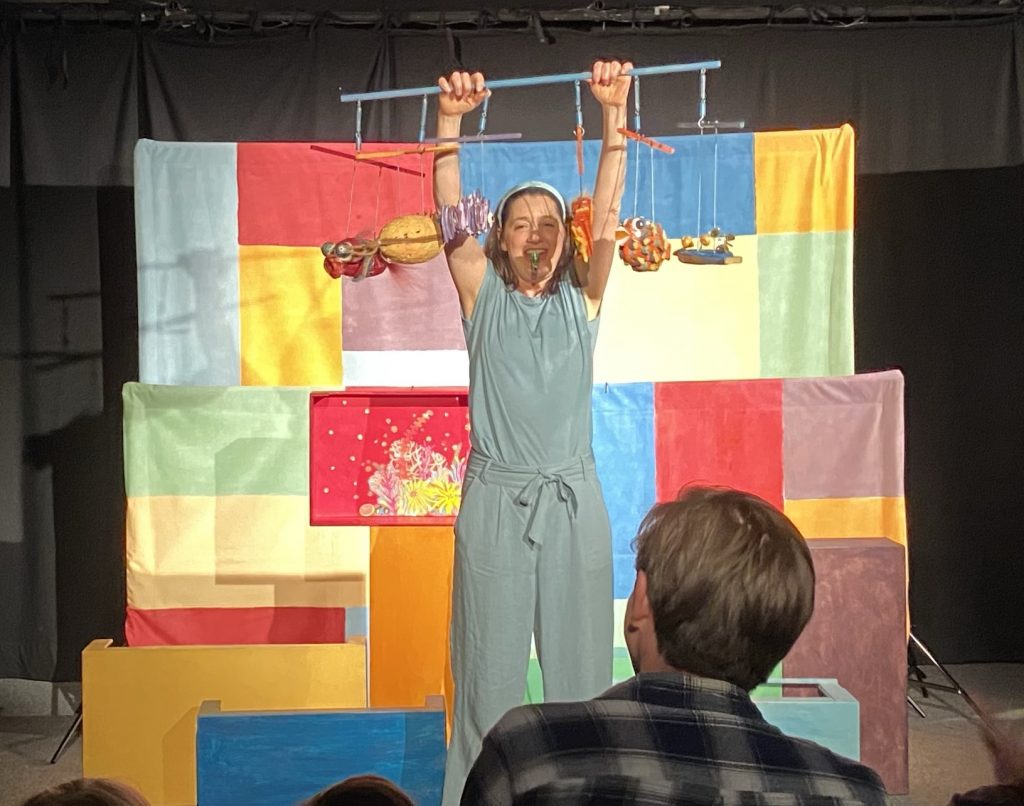
Magritte Symbol
“People always search for symbols in my works. There are none.” For those familiar with the work of Magritte, they know that he means precisely the opposite of what he is stating there. He applies well-known symbols like the white pigeon representing peace in his paintings to represent and make us think about peace. The image becomes surreal in the sense that we go beyond the real world of violence and war to lift our attention to the other surreal version of the world as it currently appears to us.
In times of war, it is more difficult to image a peaceful world and yet, this is the time we need to believe in the possibility of peace beyond the reality of aggression. In 1966 Magritte has painted “L’oiseau de ciel”, the year the peace movements became more than a surreal dream across the world. It remains a challenge to think beyond the cold war at the time and the hot war initiated by Russia in Ukraine. Surrealism helps us to think beyond the real state of affairs.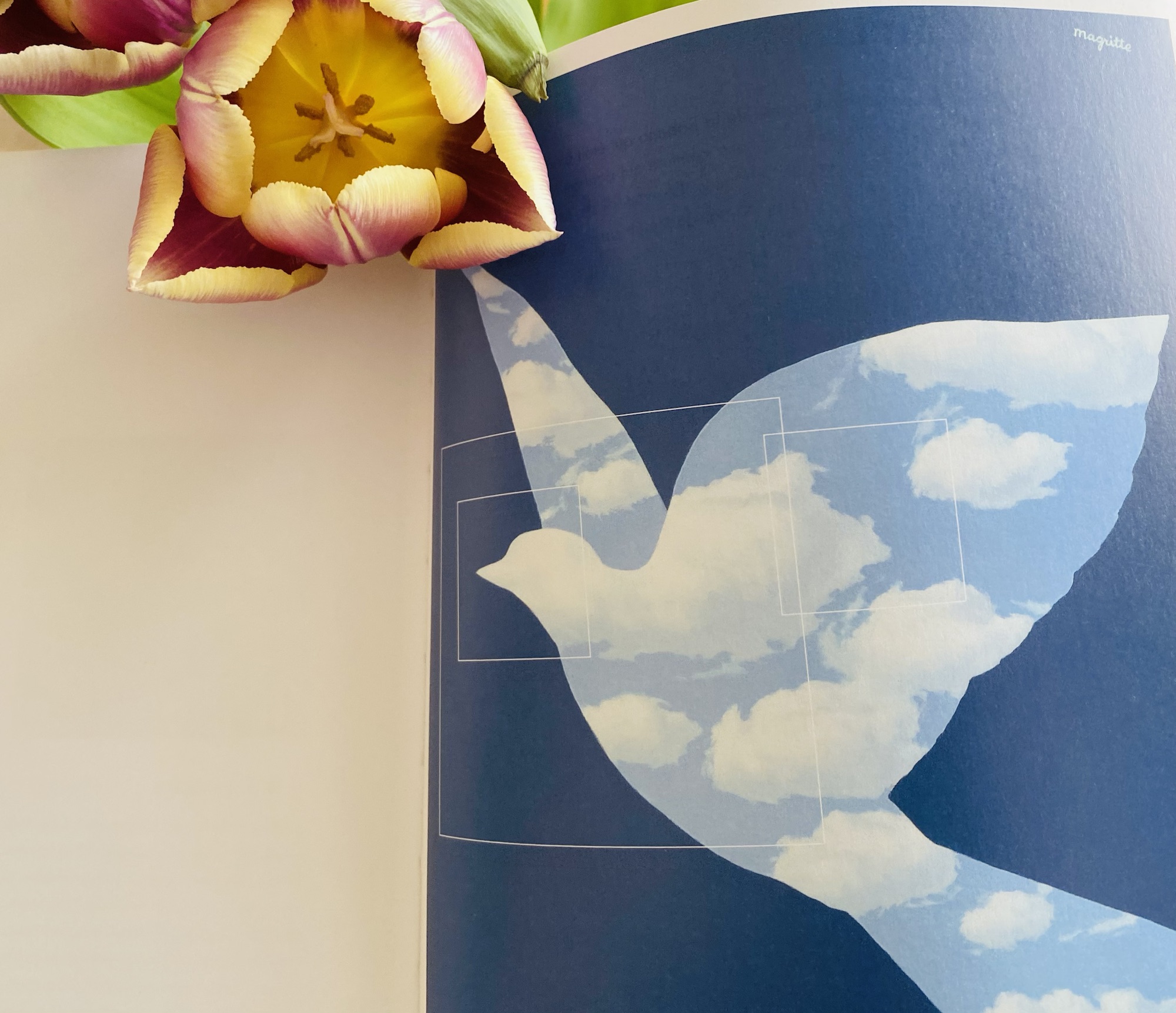
In Magritte’s own biography the “dove of peace” occurs towards the end of his own life. Whereas at the onset of his career as painter he dealt with depression and suicide in his family, towards the end of his career he moves beyond the autobiographical topics. Globally valid symbols gain the upper hand. The life course seems to have come full circle.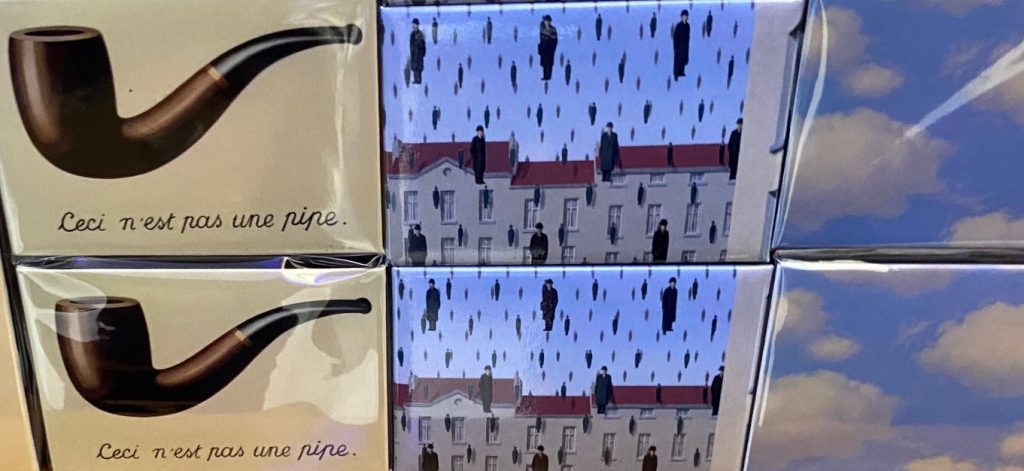
Symbol
What is it that makes an object a symbol? Probably, it is the widely shared perception of the meaning of a symbol that turns an object into a symbol. The etymology of the word symbol refers back to the Greek word σύμβολον. The earliest philosophical refer back to the Greek philosopher Aristoteles who deals with symbols when he writes about interpretations. Written words have become powerful symbols in the ancient world. We still have them all around us today. The interpretations of the words as symbols, however, may change considerably over time. Some symbols keep their designation and significance over centuries. Maps are well known to contain lots of symbols for roads, railways, tunnels or height. We learn about these symbols and interpret them in a specific societal context. Science is making ample use of symbols, e.g. chemistry. Different cultures define and apply their own symbols. Colonialism has been a form to impose symbols upon other societies. Throughout history symbols of power have changed as well. Each of those topics is an interesting field of application in itself. Young generations create their own symbols to establish a specific cultural identity or subculture. Urban spaces have been invaded by graffiti that tend to spread symbols as messages or symbols for their own sake.
Sociology has taken up the challenge to identify “status symbols” of groups of society. Possession of gold and silver have long ago been symbols of being rich. Maybe, even today such easily visible symbols play a role in how a person’s role is perceived in societies. Not only for priests etc. dresses have been applied as a symbol. Modern fashion is full of symbols as well. Interpretation of the meaning or even no meaning is an act of becoming conscious of the world around you. From the seriousness of symbols, we have come to the playing around with symbols as expressions of ourselves.
No matter whether we use the word, like water, we all know the chemical symbol H20. An image or art work using the symbol in whatever form will be decoded by us accordingly. However, the meaning we attach to water depends on the environment as well as specific context we (or the artists) are using it in. Cross-cultural competences consist in the awareness that symbols grow out of contexts and need to be interpreted accordingly. It needs a lot of openness, willingness to learn about differences and careful consideration in our everyday world to handle symbols. Doing culture is doing symbols.(Image of art work by Anderegg, Andi taken in 2016)
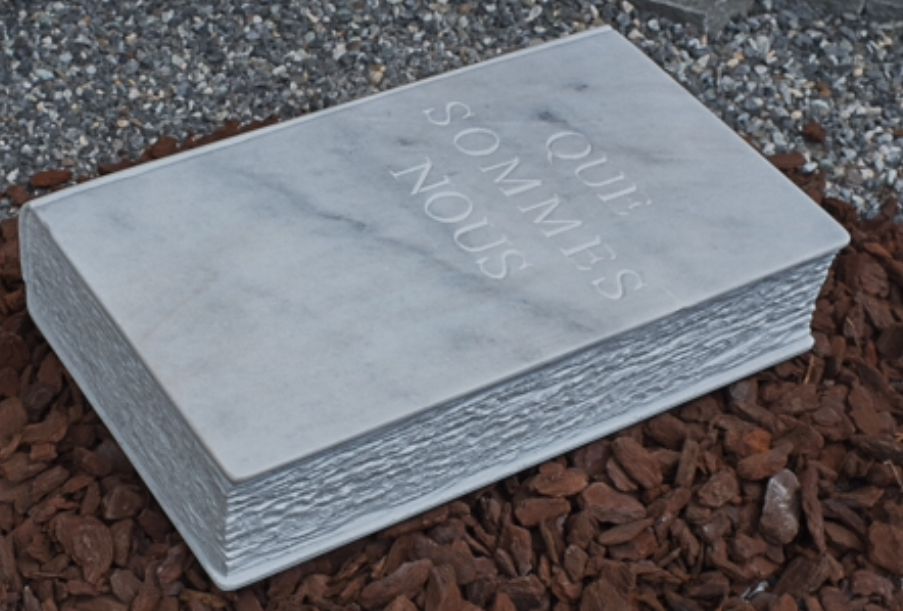
Biographies
The biographies of painters, composers or artists in general can be reconstructed by use of their major works. The biography of René Magritte by Eric Rinckhout (2017) has chosen this way of a retrospective in images and explanatory texts. The biography is built around 50 major images starting with the first one by Magritte at the age of 28. “Les réveries du promeneur” (see below) deal with the confrontation of Magritte with death, suicide and the difficulty to find rational answers to all those questions of why this happens and what becomes of people who experience such a tragedy.
His own childhood was affected by such an event concerning his own mother who suffered from depression. Coping with the evolution of psychic illness over years and the absence of a supportive father have posed a steep challenge for the young person. Creation of art became a coping strategy as well as a relief for those who manage to eventually cross the bridge into their own life leaving behind the bad experiences. J.J. Rousseau was an influence on Magritte as well.
Finding your own destiny and your own style is a process. This process evolves over years. The chronological sequence of 50 images allows to follow the path taken. Thereby, it becomes possible to open up the personal learning and working trajectory of the artist. In retrospective perspective it seems often logical that one style or period of painting follows on from another one. However, in the forward living of the creative life many choices are heavily contingent on other circumstances. Influences of friends, exhibitions, reading, cinema, private or financial situations may determine the creative choices simultaneously or one at a time.
The chronological path of images writes a biography of a special kind. It allows to think in sequences just like in a sequence analysis as sociological methodology. Description, reconstruction, analysis, causality remain a challenge in our attempts to learn and understand more about biographies or the construction and reconstruction of life courses. 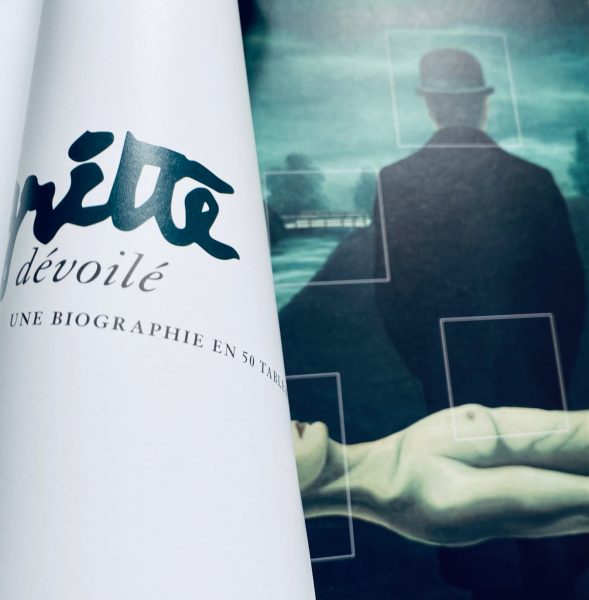
Paris 1830s
The music life in Paris in the early 19th century, almost 200 years before now, was incredibly rich. In 1828 the young Flotow arrived in Paris to receive lessons. The pianists Liszt, Chopin, Fields and Czerny passed or lived for longer times in Paris. The innovation in this period of romantic music and operas saw also a fierce competition among those talents. It was no easy task to find your niche to thrive in composition or in both performing and composing.
The 1830s had a rich urban bourgeoisie, which animated and indulged in festive events of live music and social life. Friendships of Chopin and Sand are a testimony for this. Similarly, the young Flotow and Offenbach paired to find their place in the Paris music salons and society of that time. The biography of John Field, written by Patrick Piggott (1973, p.73-81) supports this density of musical experience. The period is also characterized by the fast industrialization and the rise of the global trade. The musical life found refuge in the romantic period and more and more artistic performances by musicians. Theatres, opera houses, concert halls and private salons were meeting points of the upper social class which practices networking in rather closed circles with rather rigid routines and admission at the time.
In architecture the Operas became meeting points and a matter of national pride with National Operas contributing even to national identities. The opulent “Palais Garnier” in Paris was started in 1861 to become an iconic place in the new Paris with the huge boulevards à la Haussmann. The wealthy citizens cultivated a new lifestyle of a networked upper class that had the leisure to participate in the masses of modernity. Cultural events of all kinds filled newspapers and specialized editions. There were inner and outer circles of influence in the economic, military, political and cultural spheres.
Recommendation letters were a real currency for entry in each of these circles. Some of these social practices, have still a lot of currency even in 2024. In short, in the 1830s Paris was the place to be. Compositions of that time still fill concert halls today and their music is abundant on the new music platforms and streaming as well.
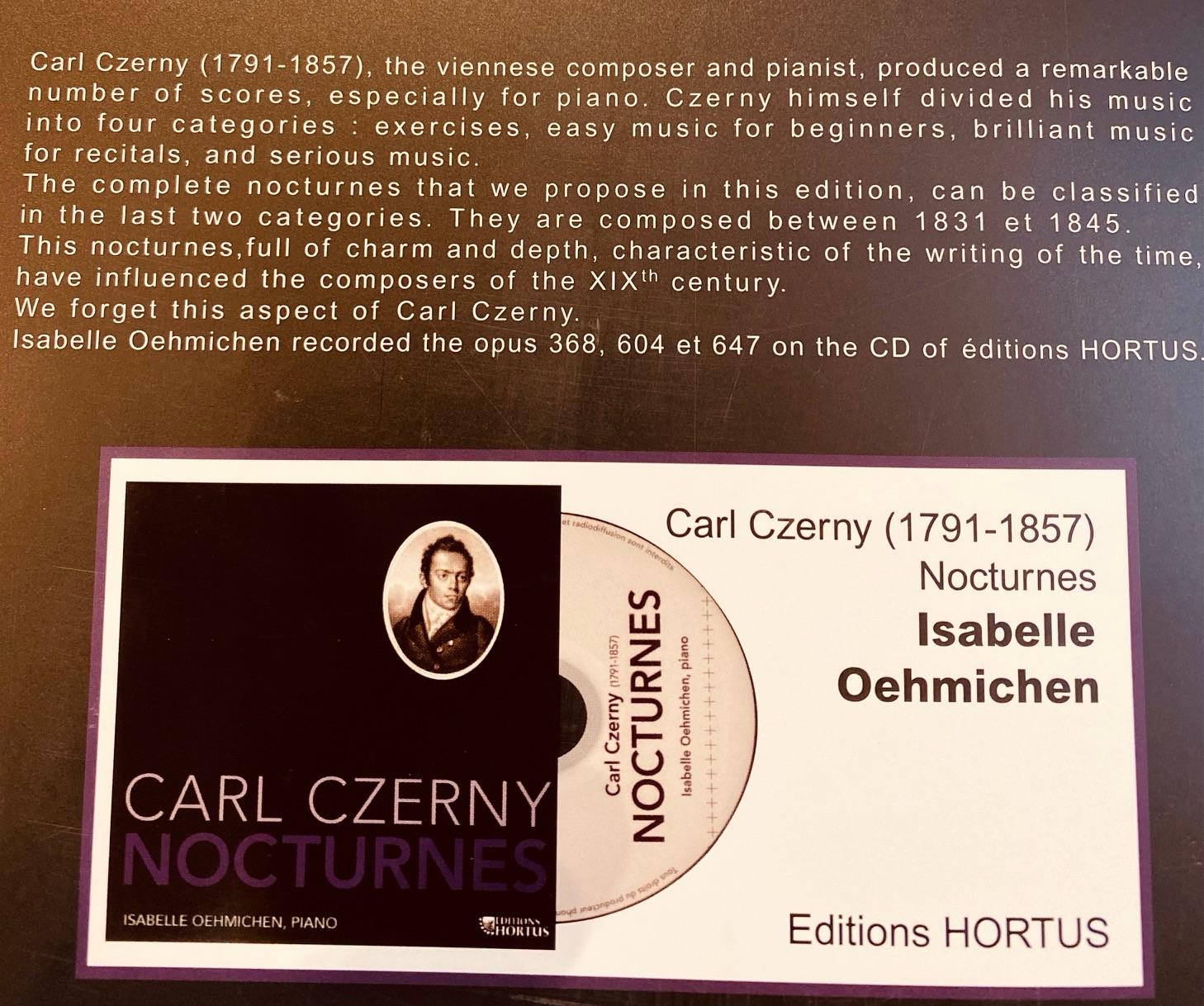
Folon Magritte
The exposition in Brussels on Folon and Magritte demonstrates the impact the latter had on the former artist. Both developed an iconic style of painting. Folon paintings apply pastel colors on paper. This style transforms images through the softened sometimes slightly blurred representations near a dream like realization. On the contrary in his sculptural work he uses hard materials to stimulate imagination and abstraction from reality. The side by side representations of Magritte and Folon is more a study in tracing influences and motifs across decades. The honor is just as much to Magritte as it is flattering Folon. Magritte had changed the life of Folon with his paintings and perspective on life beyond realism. Magritte‘s legacy lived on and Folon developed surrealism into a widely recognizable style with his paintings as well as sculptures. In walking around Brussels in 2024 you will inevitably come across some of the sculptures reflecting the work of Folon. The Folon foundation is continuing the pedagogical journey of the surrealist art movement well into today and tomorrow.
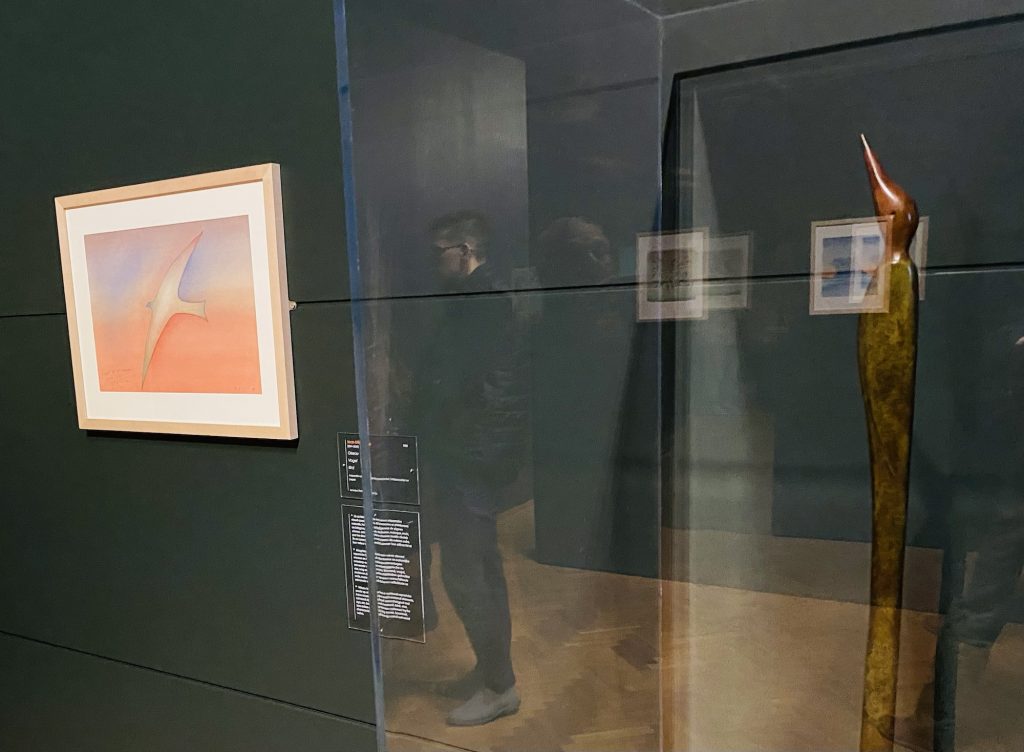
Paper and Pastel
Sometimes the art is in the material. At least this could be a rapid conclusion of the exhibition presented in London at the Royal Academy of Art in 2024-1. From the informative Catalogue the importance of material is demonstrated. The ease of taking your equipment with you, like a sketchbook and out into nature have been an important feature of the impressionists’ movement. With artists challenging traditional techniques of painting and paintings as such even the apparently less noble material as paper had become a statement of being different from the established art academies making use of more noble materials. The impressionists made a convincing point with their additional use of materials accessible to all. Capture the moment and capture your very own impression of it. This is one way to immortalize the emotion and essence of the scene. In the catalogue of the exhibition I spotted “The Swimmer” drawn by Caillebotte with pastel on paper. Freezing the moment, freezing the motion and emotion is evident here, too. Testing different materials is part of the journey to find your artistic impression, expression or materialization of imagination. The ways and means are manifold.
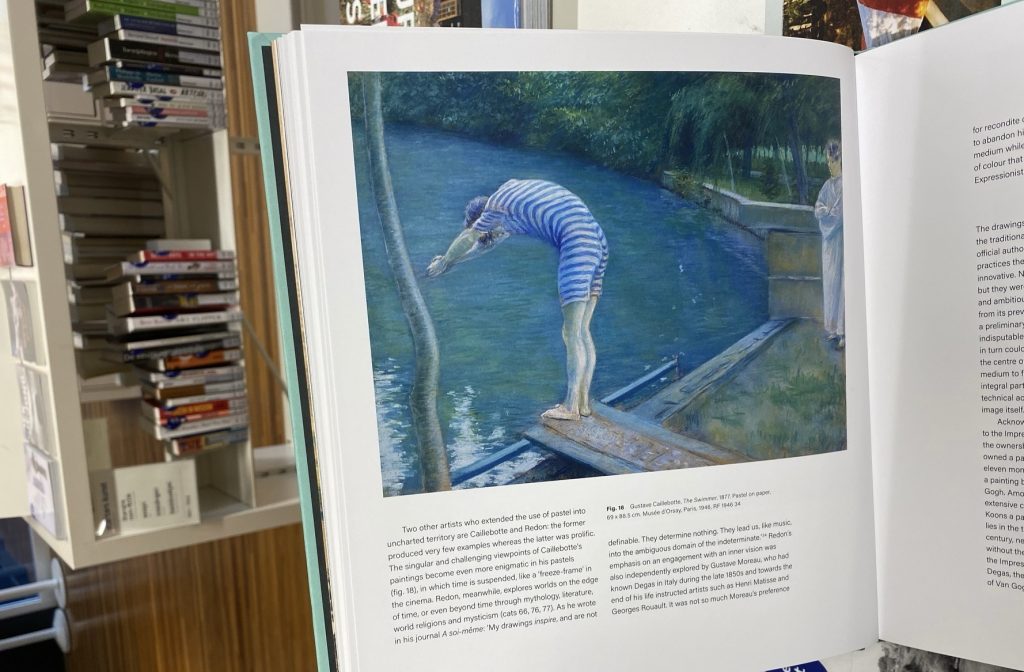
Memory Flashes
The title of the exhibition in the Museum of Photography in Berlin was “Flashes of Memory”. The collaboration of the Kunstbibliothek with the “Yad Vashem – The World Holocaust Remembrance Center” prepared a photographic memorial of the murder of 6 million of human beings with Jewish origin or family ties. The images represented in the exhibition constitute a carefully curated selection of the photos taken as part of Nazi propaganda, the secretly produced photos by inmates and the Sowjet and American soldiers who prepared documentation of the horrors. It becomes clear throughout the different sections of the exhibition that the motivation of the photographer introduces more than just an individual perspective on the scene.
In the age of fake news and fake images it becomes more and more important to be able to read and interpret photos, taking into account the motivation of the photographer and its influence on the photo taken. In order to limit the spread of mischievous representation of the past, it is good to know that the use of AI as image creation does not allow with simple prompts to produce false documentation. It needs more sophistication and more human intervention to trick the algorithms. Additional use of photoshop will, however, increase the risks of abuses. Hence, it will be more important as of now to be able to differentiate images according to sources and authors. Our trust in photos has been shattered, and this is an important lesson in itself. It is a huge task for schools and adult learning to re-build the competence to distrust photos and images at first, then deconstruct the messages and motivations.
“Flashes of memory” is in some way linked to the “struggle of memory” exhibition. Both, obviously deal with the way historical events are and have to be present in our “collective” memory. Memories come back in flashes, sometimes, certainly for victims. Conscious and unconscious selections of images might come back at times and haunt victims for years. The correction of biased messages, is an important task for historians, social scientists and artists alike. It is all too easy and common to forget (Luhmann, 1996 Reality of mass media) and the difference between “Documentation” and “Decoration” (Lewis, 2001) or simply illustration needs to be scrutinised always anew. “Bildung” has some common roots (only four letters really) with “Bilder” in German language. It may be “une liaison dangereuse”, but the spurious link can also be turned into an educational or learning approach.
A permanent exhibition based on the material used in the exhibition would be a real asset to accompany and learn about the flashes of memory. A reading list of literature was also available at the exhibition (see image below) encouraging to dig deeper into this immensely important topic. 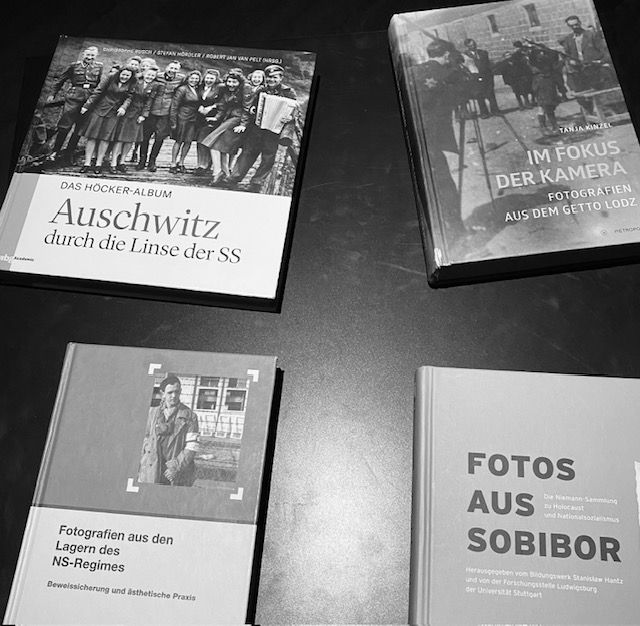
Postmodernism
The grand narratives of the modern world, like modernism itself, are under serious criticism. Deconstruction of the modern way of thinking has become philosophical mainstream. Economics as a science is in the middle of the behavioural shift and changing or at least complementing its narratives. Sociology has embraced postmodern thinking in theoretical as well as empirical forms (Mirchandani, 2005). The empirical measurement focuses a lot on the groups and people who hold postmodern beliefs and values. The discussion in the social and literary sciences continue. In the arts reading on modernism and postmodernism is a must in order to understand much of contemporary art or art from the 19th and 20th century.
Bookstores in art galleries that cover long spells of history can make surprising links between historical periods of art. Books of postmodernism appear next to books on romanticism. A lot of the ideation of postmodernism rejoins romantic depiction about nature, re-naturalizing or the emotional connotations of wildlife, isolated places and stillness.
On the other hand, we are confronted with the brutal world of war, drugs and crime. Classical warfare and strategies are back in Europe with tanks and rockets killing like in previous wars. The Russian empire of a specific version of modernism strikes back as if it were to stop the postmodern turn of the 21st century. Neo-fascism tries to build on the losers of the transitions to the socio-ecological economy and society. There are manifold backlashes of modernism, but the postmodern world is under continuous construction, most of in our mindsets. 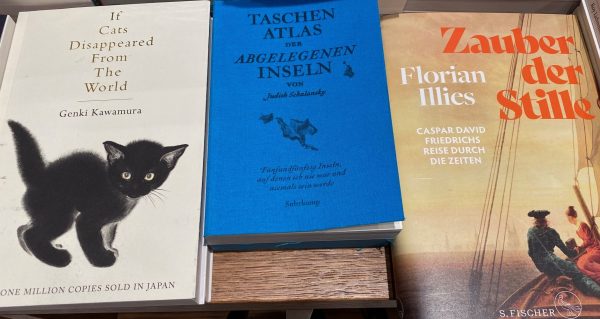
Memory Struggle
The struggle of memory is also the memory of a struggle. The exhibition in the Palais Populaire in Berlin doesn’t leave spectators untouched. It is a struggle to recover memories which were attempted to be eradicated. This is the univeral message of this exhibition. The colonial past and crimes are part of the struggles of artists from these cultures to re-establish their rights to their own views, traditions and memories. Grass and plants may cover the shelled soil and people, but traces or mortars are often left behind. Light from different angles needs to be shed on these places to reveal the shadows of the wounds. The atrocities and exploitation linked to colonialism and imperialism keeps us struggling with those memories. Just before we jump to the conclusion that it is a memory of a past struggle, we are reminded that consequences are still haunting the present and with the Russian aggression in Ukraine we have to realize the fight against imperialism continues in the 21st century. Thanks for memorable moments and impressions in view of a global arts and history experience. (Image of art work installation by Sammy Boloji, untitled 2018, exhibition Palais Populaire, Deutsche Bank foundation)
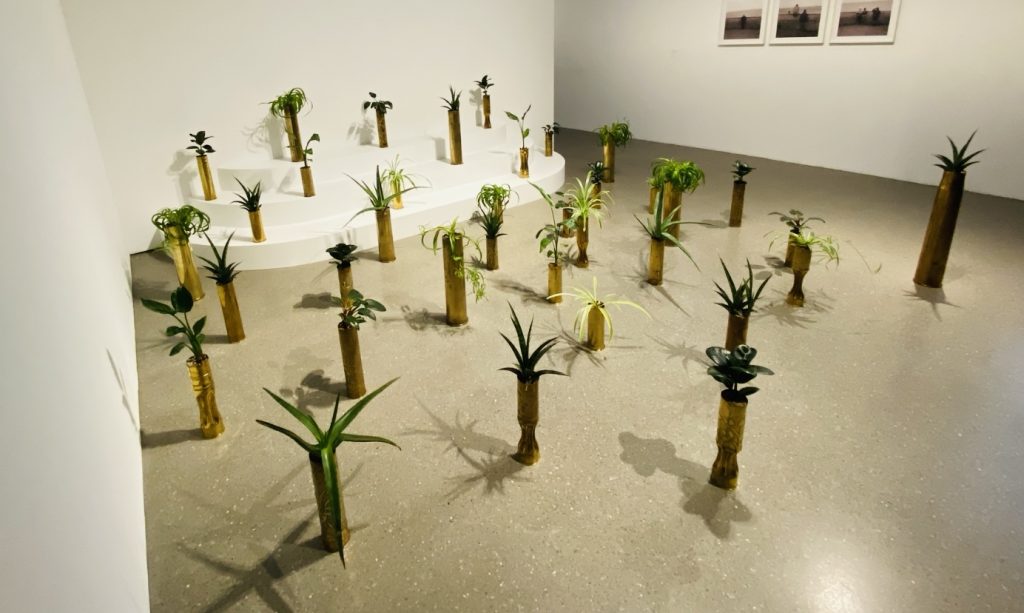
Ideal City
Ideal City
Even beyond humans the issue of what constitutes the ideal city is a matter of historical as well as experimental significance. Science has recently uncovered a city like organization of habitats in the Amazon region (Link Science.org). The organization of the Greek city states has been the model for the development of democratic ideation. The Roman imperialism has thrived through the splendor of its cities and city lifestyle. No surprise that this continues to be a constant concern for humanity.
Rapid urbanization continues in Africa and Asia. Europe also struggles to keep pace with infrastructure development in every growing cities. Whereas the ideal city in the early Italian Renaissance was imagined without trees, we witness a renewed interest to bring back nature-like environments and architecture back into cities. Combining the best of 2 worlds seems possible. Redesigning inner cities remains a continuous challenge. It is much more than thinking about bricks and mortar. It is mostly about how we want to live, work and communicate together. Therefore, it concerns all of us. Paintings help us along in our ideation about where and how we want to live together. The linear views of the Renaissance appear hardly convenient after the experience of the 20th century.
(Image Gemäldegalerie Berlin, 2024-1, Raum XVIII, Ident Nr. 1615 “Ideal city” from ca 1490 attributed to Francesco di Giogio Martini and next to well-known ideal “Venus” painting by Sandro Botticelli 1490). 